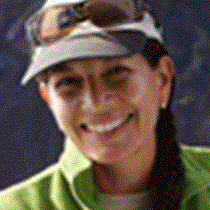Fernandina and Isabela Islands
On our second night in Galápagos, we crossed the equator at night as we traveled north around the island of Isabela, to enter the westernmost realm of the Galápagos.
This was our best opportunity to look for marine mammals such as whales and dolphins, as the frigid waters of the deep equatorial countercurrent rise up along the western edge of the undersea Galápagos Platform. This upwelling phenomenon creates extraordinary conditions for a very rich marine ecosystem, thick sea fogs and remarkably cool sea temperatures, which we experienced later while snorkeling.
We dedicated the entire morning to visiting Fernandina Island, an imposing volcano rising to nearly 5,000 feet in elevation, one of the most active volcanoes in the world and the world's largest completely pristine island.
Photographers had the chance to go ashore very early in the morning, and natural history groups a little later, to explore this very unspoiled site.
We landed at Punta Espinosa over solid black slabs of "pahoehoe,” or ropy lava. Hundreds of marine iguanas were basking on the dark lava, while in the tide pools many sea lions pups were beginning a new day of adventure and discovery and sea turtles were popping their heads out of the water to get some air.
We saw our first flightless cormorants, some resting on the shore and others diving for food, and of course we had the chance to understand some of the geology of the islands and see some remarkable plants such as the lava cactus, capable of growing in barren lava fields.
After the walk, we explored the underwater lava coastline of Fernandina, and some of us were accompanied by Galápagos penguins, flightless cormorants, marine iguanas and sea turtles!
Early in the afternoon, we crossed the equator line while all of us were admiring the fantastic geology of Ecuador Volcano on Isabela Island. This spectacular shield volcano, which is bisected by the equator, collapsed and slumped away into the ocean, leaving fascinating views of the inner caldera wall and the caldera floor.
Later we went for a Zodiac ride along the base of the imposing cliffs, where we saw many Galápagos fur seals and marine iguanas as well as Nazca boobies, brown noddy terns and swallow-tailed gulls. But that was not all, as we were lucky enough to find several Galápagos penguins, flightless cormorants, dozens of sea turtles and the always-fascinating-but-awkward-looking “mola-mola” or sunfish.
With the spectacular background of Wolf Volcano and a glass of champagne, we celebrated the joy of being part of this unique place on earth.




